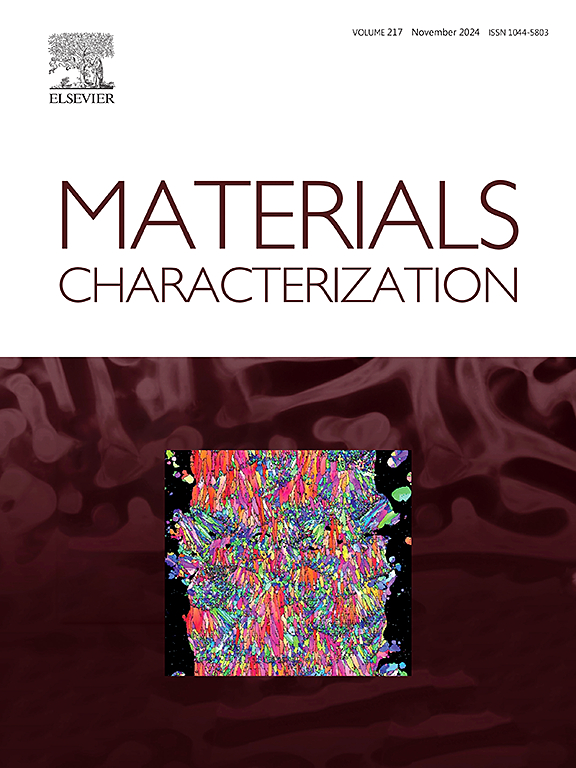Fabrication of Al/Ni multilayers with excellent layer continuity by combination of accumulative pack rolling and roll bonding
IF 5.5
2区 材料科学
Q1 MATERIALS SCIENCE, CHARACTERIZATION & TESTING
引用次数: 0
Abstract
Fabrication of Al/Ni multilayer sheets with great layer continuity has always been a challenge due to early necking and rupture of Ni layer in rolling process, which usually results in a structure with Ni fragments in Al matrix and induces poor thermal performance. This study investigates the fabrication and characterization of Al/Ni multilayer sheets with a focus on achieving excellent layer continuity. The multilayers were prepared using accumulative pack rolling (APR) and roll bonding techniques, combining aluminum alloys (AA1050 and AA7075) with Ni to form laminated composites with controlled thickness ratios. The mechanical compatibility between materials by heat treatment and warm roll bonding was emphasized to mitigate plastic instability, such as shear banding and necking, which disrupt layer continuity. Differential scanning calorimetry (DSC) was employed to evaluate the thermal performance and the formation of intermetallic compounds, including Al3Ni and Al3Ni2. The results indicate that AA7075/Ni multilayers exhibit excellent structural integrity and thermal response compared to AA1050/Ni. While achieving bilayer thicknesses as thin as 5–10 μm, the study also highlights the issues of bonding quality in thinner layers and the impact of thickness ratios on heat release efficiency. This work demonstrates the potential of heat treatment and warm roll bonding as cost-effective, scalable methods for fabricating high-performance AA7075/Ni multilayers and provides valuable insights into optimizing their design for thermal and mechanical applications.
利用累积积层轧制和轧制键合相结合的方法制备具有优异层连续性的Al/Ni多层膜
由于轧制过程中Ni层的早期颈缩和断裂,导致Al基体中存在Ni碎片结构,热性能较差,因此制备具有良好层连续性的Al/Ni多层片一直是一个难题。本研究探讨了Al/Ni多层片的制备和表征,重点是实现优异的层连续性。采用累积包轧(APR)和轧制结合技术,将铝合金(AA1050和AA7075)与Ni结合,形成控制厚度比的层状复合材料。强调热处理和热轧粘合材料之间的力学相容性,以减轻塑性不稳定性,如剪切带和颈缩,破坏层的连续性。采用差示扫描量热法(DSC)评价了Al3Ni和Al3Ni2等金属间化合物的热性能和形成情况。结果表明,与AA1050/Ni相比,AA7075/Ni多层膜具有良好的结构完整性和热响应性能。在实现薄至5-10 μm的双分子层厚度的同时,研究还强调了薄层的键合质量问题以及厚度比对放热效率的影响。这项工作证明了热处理和热辊粘合作为制造高性能AA7075/Ni多层材料的成本效益高、可扩展的方法的潜力,并为优化其热学和机械应用的设计提供了宝贵的见解。
本文章由计算机程序翻译,如有差异,请以英文原文为准。
求助全文
约1分钟内获得全文
求助全文
来源期刊

Materials Characterization
工程技术-材料科学:表征与测试
CiteScore
7.60
自引率
8.50%
发文量
746
审稿时长
36 days
期刊介绍:
Materials Characterization features original articles and state-of-the-art reviews on theoretical and practical aspects of the structure and behaviour of materials.
The Journal focuses on all characterization techniques, including all forms of microscopy (light, electron, acoustic, etc.,) and analysis (especially microanalysis and surface analytical techniques). Developments in both this wide range of techniques and their application to the quantification of the microstructure of materials are essential facets of the Journal.
The Journal provides the Materials Scientist/Engineer with up-to-date information on many types of materials with an underlying theme of explaining the behavior of materials using novel approaches. Materials covered by the journal include:
Metals & Alloys
Ceramics
Nanomaterials
Biomedical materials
Optical materials
Composites
Natural Materials.
 求助内容:
求助内容: 应助结果提醒方式:
应助结果提醒方式:


